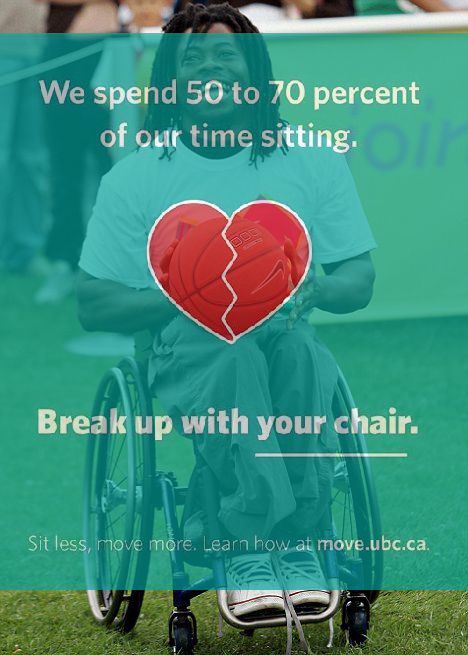 Upon first seeing posters and online advertisements for the current #MoveUBC campaign launched on our campus this month, I was immediately struck by some of the underlying assumptions the campaign carries and the underlying oppressions it thereby perpetuates. While the campaign’s messaging, the promotion of health, exercise, and wellbeing, is undeniably positive, I believe that the decisions behind the graphic and execution of the advertising itself, with the tag line “Sit less, move more”, carries less benign connotations beneath the surface. Most apparent in the ad messaging is the normative representation of physical health which is founded upon an ablest assumption of movement capability. On a campus the size of UBC, with students, faculty, staff and community who have a diversity of body types, appearances and abilities, it is an act of marginalization and erasure to promote well-being as narrowly achievable through movement. The suggestion to “break up with your chair”, or spend more time standing or walking in order to improve health, isolates and stigmatizes individuals who have mobility restrictions, both visible and invisible, and is reminiscent of the discriminatory notion that people with physical disabilities are a burden on capitalist society because they are viewed as permanently unwell and incapable of contributing to the workforce. By correlating good health to movement, specifically standing and walking, the #MoveUBC campaign perpetuates an ablest construction of fitness and well-being and effectively excludes individuals who are unable to “break up with their chair” from being recognized as healthy members of the UBC community.
Upon first seeing posters and online advertisements for the current #MoveUBC campaign launched on our campus this month, I was immediately struck by some of the underlying assumptions the campaign carries and the underlying oppressions it thereby perpetuates. While the campaign’s messaging, the promotion of health, exercise, and wellbeing, is undeniably positive, I believe that the decisions behind the graphic and execution of the advertising itself, with the tag line “Sit less, move more”, carries less benign connotations beneath the surface. Most apparent in the ad messaging is the normative representation of physical health which is founded upon an ablest assumption of movement capability. On a campus the size of UBC, with students, faculty, staff and community who have a diversity of body types, appearances and abilities, it is an act of marginalization and erasure to promote well-being as narrowly achievable through movement. The suggestion to “break up with your chair”, or spend more time standing or walking in order to improve health, isolates and stigmatizes individuals who have mobility restrictions, both visible and invisible, and is reminiscent of the discriminatory notion that people with physical disabilities are a burden on capitalist society because they are viewed as permanently unwell and incapable of contributing to the workforce. By correlating good health to movement, specifically standing and walking, the #MoveUBC campaign perpetuates an ablest construction of fitness and well-being and effectively excludes individuals who are unable to “break up with their chair” from being recognized as healthy members of the UBC community.
In altering the original advertisement I want to bring to light the bodies which I feel are erased by a campaign beseeching the UBC community to spend more time standing and walking. By revealing an individual who requires a mobility aid and is unable to stand or walk through the promotional graphic, I am challenging the viewer to reconcile the implicit exclusion of some bodies from the university’s advertisement messaging .
.
Additionally, I want to query the decision to launch the #MoveUBC campaign over the month of February, which is Black History Month in Canada, as well as internationally in the United States and Britain. I initially became aware of the #MoveUBC campaign in UBC’s February newsletter (UBCfyi) and noted that UBC had no programming for, or even mention of, Black History Month, and instead was dubbing February as “MoveUBC Month”. In choosing to launch this health and wellness campaign instead of promoting Black History Month, UBC distracts from important work taking place in February to address historic and ongoing racism, and exposes UBC’s failure to recognize racialized discrimination on our campus as a serious issue by taking action against it. In highlighting this erasure of Black History Month and in an effort to instead feature people of colour who are often underrepresented in advertisement media, I chose to feature black Paralympian Ade Adepitan in my alteration of the original advertisement.
In presenting my critical modification of the #MoveUBC promotional graphic I want to be mindful of all people with physical restrictions, particularly those who have invisible disabilities. While the graphic medium of the culture jam lends itself to portraying the erasure of people with visible disabilities, it is important to consider how this advertisement, which endorses movement, might expose people with invisible mobility restrictions to greater stigma when their ability to move may be impaired. A few years ago I had a major surgery on my hip which restricted my standing and walking for a year after all physical signs of recovery had disappeared. In this time I became acutely aware of the attention and judgement cast towards people who appear able bodied but must take the elevator or have a seat on the bus. I cannot imagine how challenging it must be to have the added pressure of a campaign such as #MoveUBC when already facing invalidation and stigma for your mobility needs.
Work Cited
“Ade Adepitan Representing Britain in 2004 Paralympic Games.” Daily Mail, 2004. Web. 16 February 2017. <http://i.dailymail.co.uk/i/pix/2011/10/28/article-2054821- 0E939ECB00000578-166_468x655.jpg>.
“Break Up with Your Chair.” Instagram, 02 February 2017. Graphic. 16 February 2017.